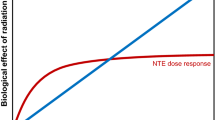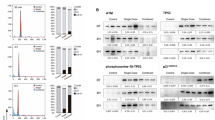Abstract
These experiments were done to determine if interference with energy metabolism and REDOX biochemistry during low LET radiation exposure would alter the ability of medium harvested from the irradiated cells to induce a bystander effect in unirradiated cells. Human keratinocyte cells and CHO-K1 mutant cell lines were irradiated using cobalt 60. Clonogenic assays were used to determine the reproductive death of the cells exposed to direct irradiation or medium from irradiated cells. The persistence in progeny was also examined. Use of apoptosis inhibitors or medium from the LDH or G6PD null cell lines, reduced or prevented the bystander effect. Transfection with G6PD recovered the effect. Treatment with anti-oxidant substances, L -lactate and L -deprenyl prevented bystander factor associated cell kill. The lactate analogue, oxamate, was less effective. Data from experiments where media harvested from the different cell lines was exchanged suggest that signal production and cellular response may involve different mechanisms. The effects on exposed cells were transmitted to progeny which also showed excessive levels of cell death for several generations. The results suggest that energy/REDOX metabolism may be involved in the expression of a radiation induced bystander response. Given the aberrant energy metabolism in tumour cells, this may have implications for dose escalation in radiotherapy. © 2000 Cancer Research Campaign
Similar content being viewed by others
Article PDF
Change history
16 November 2011
This paper was modified 12 months after initial publication to switch to Creative Commons licence terms, as noted at publication
References
Clutton SM, Townsend KMS, Walker C, Ansell JD and Wright EG (1996) Radiation induced genomic instability and persisting oxidative stress in primary bone marrow cultures. Carcinogenesis 17: 1633–1639
Deshpande A, Goodwin EH, Bailey SM, Marrone BL and Lehnert BE (1997) Alpha-particle-induced sister chromatid exchange in normal human lung fibroblasts: evidence for an extra-nuclear target. Radiat Res 145: 260–267
Emerit I, Filipe P, Meunier P, Auclair C, Freitas J, Deroussent A, Gouyette A and Fernandes A (1997) Clastogenic activity in the plasma of scleroderma patients: a biomarker of oxidative stress. Dermatology 194: 140–146
Green DR and Reed JC (1998) Mitochondria and apoptosis. Science 281: 1309–1312
Hall EJ (1994) Radiobiology for the Radiologist, 4th edn. Lippencott and Lippencott: Philadelphia
Hockenberry D, Nuñez G, Milliman C, Schreiber RD and Korsmeyer SJ (1990) Bcl-2 is an inner mitochondrial membrane protein that blocks programmed cell death. Nature 348: 334–336
Jacobson MD, Burne JF, King MP, Miyashita TM, Reed JC and Raff MC (1993) Bcl-2 blocks apoptosis in cells lacking mitochondrial DNA. Nature 361: 365–369
Kluck RM, Bossy-Wetzel E, Green DR and Newmeyer DD (1997) The release of cytochrome c from mitochondria: a primary site for Bcl-2 regulation of apoptosis. Science 275: 1132–1136
Kroemer G, Zamzami N and Susin SA (1997) Mitochondrial control of apoptosis. Immunol Today 18: 44–51
Kumar S (1995) ICE-like proteases in apoptosis. Trends Biochem Sci 29: 198–202
Lehnert BE and Goodwin EH (1997) Extracellular factor(s) following exposure to alpha-particles can cause sister chromatid exchanges in normal human cells. Cancer Res 57: 2164–2171
Lorimore SA, Kadhim MA, Pocock DA, Papworth D, Stevens DL, Goodhead DT and Wright EG (1998) Chromosomal instability in the descendants of unirradiated surviving cells after α-particle irradiation. Proc Natl Acad Sci USA 95: 5730–5733
Mooney RE (1999) The effect of L -deprenyl on survival and induction of genomic instability in human keratinocytes exposed to gamma-irradiation or chemotherapy drugs, PhD thesis, University of Dublin
Morgan WF, Day JP, Kaplan MI, McGhee EM and Limoli CL (1996) Genomic instability induced by ionizing radiation. Radiat Res 146: 247–258
Mothersill C and Seymour CB (1986) Effect of lactate on the recovery of CHO-KI cells from gamma radiation damage. Acta Radiol Oncol 25: 71–76
Mothersill C and Seymour CB (1997 a) Medium from irradiated human epithelial cells but not human fibroblasts reduces the clonogenic survival of unirradiated cells. Int J Radiat Biol 71: 421–427
Mothersill C and Seymour CB (1997 b) Lethal mutations and genomic instability. Int J Radiat Biol 71: 751–758
Mothersill C and Seymour CB (1998 a) Cell–cell contact during gamma irradiation is not required to induce a bystander effect in normal human keratinocytes: evidence for release during irradiation of a signal controlling survival into the medium. Radiat Res 149: 256–262
Mothersill C and Seymour CB (1998 b) Mechanisms and implications of genomic instability and other delayed effects of ionizing radiation exposure. Mutagenesis 13: 421–426
Nicholson DW and Thornberry NA (1997) Caspases: killer proteases. Trends Biochem Sci 22: 299–306
Pirisi L, Yasumoto,, Feller S, Doniger J and DiPaolo J (1988) Transformation of human fibroblasts and keratinocytes with human papillomavirus type 16 DNA. J Virol 61: 1061–1066
Puck TT and Marcus PI (1956) Action of X-rays on mammalian cells. J Exp Med 103: 653–666
Seymour CB (1983) Radiobiological effects of lactate and glycolysis inhibitors on cultured mammalian cells. PhD thesis, University of Dublin, Trinity College
Seymour CB and Mothersill C (1981) The radiobiological effects of lactate on cells in culture. Int J Radiat Biol 40: 283–293
Seymour CB and Mothersill C (1987) The effect of glycolysis inhibitors on the recovery of CHO-KI cells from split-dose irradiation. Acta Radiol Oncol 26: 367–371
Seymour CB and Mothersill C (1988) The effect of glycolysis inhibitors on the radiation response of CHOI-KI cells. Radiat Environ Biophys 27: 49–57
Seymour CB and Mothersill C (1997) Delayed expression of lethal mutations and genomic instability in the progeny of human epithelial cells that survived in a bystander-killing environment. Radiat Oncol Invest 5: 106–110
Seymour CB, Mothersill C and Moriarty M (1985) Glucose analogues alter the response of CHO-KI cells to gamma irradiation. Acta Radiol Oncol 24: 351–356
Stamato T, Weinstein R, Peters B, Hu J, Doherty B and Giaccia A (1987) Delayed mutation in Chinese hamster cells. Somatic Cell Mol Genet 13: 57–66
Thornberry NA and Lazebnik Y (1998) Caspases: enemies within. Science 281: 1312–1316
Villa P, Kaufmann SH and Earnshaw WC (1997) Caspases and caspase inhibitors. Trends Biochemi Sci 22: 388–393
Wu L-J, Randers-Pehrson G, Waldren CA, Geard CR, Yu ZL and Hei TK (1999) Targeted cytoplasmic irradiation with Alpha particles induces mutations in mammalian cells. Proc Natl Acad Sci USA 96 (in press)
Zamzami N, Marchetti P, Castedo M, Hirsch T, Susin SA, Masse B and Kroemer G (1996) Inhibitors of permeability transition interfere with the disruption of the mitochondrial transmembrane potential during apoptosis. Fed Eur Biochem Soc Lett 384: 53–57
Author information
Authors and Affiliations
Rights and permissions
From twelve months after its original publication, this work is licensed under the Creative Commons Attribution-NonCommercial-Share Alike 3.0 Unported License. To view a copy of this license, visit http://creativecommons.org/licenses/by-nc-sa/3.0/
About this article
Cite this article
Mothersill, C., Stamato, T., Perez, M. et al. Involvement of energy metabolism in the production of ‘bystander effects’ by radiation. Br J Cancer 82, 1740–1746 (2000). https://doi.org/10.1054/bjoc.2000.1109
Received:
Revised:
Accepted:
Published:
Issue date:
DOI: https://doi.org/10.1054/bjoc.2000.1109
Keywords
This article is cited by
-
Intercellular communications-redox interactions in radiation toxicity; potential targets for radiation mitigation
Journal of Cell Communication and Signaling (2019)
-
Surgical wound fluids from patients treated with intraoperative radiotherapy induce radiobiological response in breast cancer cells
Medical Oncology (2019)
-
Integrated Modelling of Cell Responses after Irradiation for DNA-Targeted Effects and Non-Targeted Effects
Scientific Reports (2018)
-
Uncomfortable issues in radiation protection posed by low-dose radiobiology
Radiation and Environmental Biophysics (2013)
-
Emerging role of radiation induced bystander effects: Cell communications and carcinogenesis
Genome Integrity (2010)



